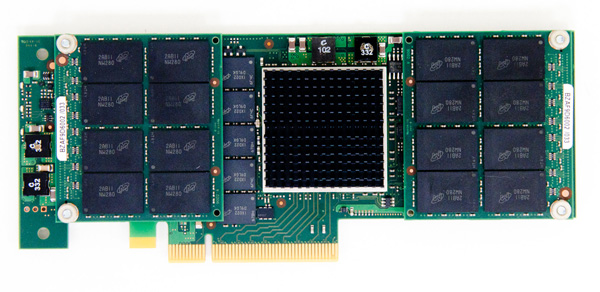Micron P320h PCIe SSD (700GB) Review
by Anand Lal Shimpi on October 15, 2012 3:00 AM ESTFinal Words
Update: Micron tells us that the P320h doesn't support NVMe, we are digging to understand how Micron's controller differs from the NVMe IDT controller with a similar part number.
For Micron's first PCIe SSD, the P320h performs very well. Random read and write performance are untouched by any non-SandForce architecture we've tested here. Average service times in our application based workload traces are also class leading, presumably as a result of the IDT controller and lightweight PCIe controller. Sequential performance is also very good and potentially even better under heavier workloads. The fact that there's no claimed performance difference between the 350GB and 700GB drives is good for users who don't have giant workload footprints. Overall it's an impressive step forward. The native PCIe architecture makes a lot of sense and will hopefully quickly supplant the current crop of SATA-RAID-on-a-PCIe-card solutions on the market today. Where things will get really interesting is when we start coupling multiple PCIe SSDs in a system.
The downsides to the P320h are obvious. By using 34nm SLC NAND Micron ensures wonderful endurance, but prices the solution out of the reach of many customers whose needs don't require such high endurance. Until Micron brings eMLC/MLC-HET NAND to the P320h, I suspect the more conventional PCIe SSDs (e.g. Intel's SSD 910) will remain better values. For the subset of users who require SLC endurance however, the P320h should definitely fit the bill.
The second downside is just as fundamental: the driver stack is still in its infancy. Although the ultimate goal is SATA-like compatibility with all systems, it will take some time to get there. Until that day comes, if you're considering the P320h you'll want to make sure that Micron has validated the drive on your platform.
PCIe is the future. I don't expect a smooth ride to get us there, but it's where solid state storage is headed - particularly in the enterprise market. The P320h is a good starting point, I'm eager to see where Micron takes it.











57 Comments
View All Comments
speculatrix - Tuesday, October 16, 2012 - link
flash memory comes in different forms and longevities.the best SLC flash will outperform and outlast the cheapest TLC flash by considerable margins, but at a cost.
car analogy: do you want a performance car which is extremely well built and designed to survive in harsh environments, or a cheap family car which can only survive a Californian "winter"?
milkod2001 - Monday, October 15, 2012 - link
They have to make this thing bootable and sell 120GB version for 300 bucks max, until then this is just like reading about NASA's new spaceship(interesting but no use for 99% of users)kevith - Monday, October 15, 2012 - link
Spot on!A5 - Monday, October 15, 2012 - link
If you only care about consumer-ready cheap stuff, there are plenty of really boring tech sites out there for you to read.ender8282 - Monday, October 15, 2012 - link
I was just talking with a co-worker a little while ago about how a device like this would give us more head room. It is extremely relevant to our workload, and I'm glad to see this article. Just because it isn't for home use you shouldn't ignore it. If this technology works (and works well) in the enterprise market, it will likely eventually trickle down to the consumer market. Would have liked to see prices, but if this is comparable to a high end raid controller, plus a bunch of fast SSDs it will likely be an option for lots of people.taltamir - Monday, October 15, 2012 - link
This is not for home users, its for enterprises with a lot of money and extreme speed needs.mattlach - Tuesday, October 16, 2012 - link
It's not intended for you, or me, or any other consumers.This is a enterprise server part, and for that market its probably priced about right.
I would LOVE to see a bootable native PCIe consumer drive with MLC NAND priced more reasonably for the consumer market, and we likely will in the not TOO distant future, but they aren't here yet.
zlyles - Tuesday, October 16, 2012 - link
What you fail to realize is these SSD's (Micron P320h, Intel 910 and OCZ Z-Drive) are targeted at enterprise markets. The majority of these enterprise customers would purchase these drives as high IOPS storage or for running virtual servers/desktops from. Most of these companies are likely using a virtualized solution(VMware ESXi) in which case the hypervisor is loaded into ram at boot anyway, not much point in booting the OS from SSD.If you are looking for a solution for 99% of users, I'm not really sure why you are even looking at PCI-e SSD's, there is a VERY small market for PCI-e SSD's(bootable or not) on the consumer side.
JellyRoll - Monday, October 15, 2012 - link
Man! For the tens of thousands of dollars that customers would spend on one of these SSDs there is no way in the world that anyone would ever run one under 128QD, ever.These are designed to be run 100% full bore, not at QD 1. These benchmarks are totally irrelevant, and have no real meaning. This is like testing an Nascar vehicle in a small parking lot.
Sivar - Monday, October 15, 2012 - link
You're right, who in their right mind would run all these irrelevant real-world database tests to see actual performance in the target market?I'm sure you're speaking from a lot of industry experience. I'm also sure you've ever seen a sustained queue depth of 128 on any real-world system.